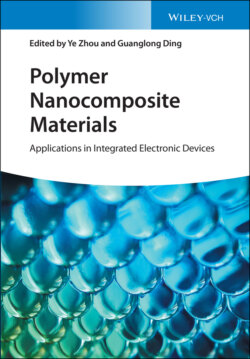Читать книгу Polymer Nanocomposite Materials - Группа авторов - Страница 39
2.3.2.2 Surface Coating
ОглавлениеTo prepare CPCs with a low percolation, a high conductivity at a low filler content, and meanwhile no evident fillers aggregation in polymer matrix, decoration of conductive nanofillers on the skeleton (out surface) of the polymer material tends to be an effective solution, which includes dip coating [101, 102], spray coating [103, 104], and ultrasonication [105, 106]. Note that the polymer materials usually possess a porous structure (e.g. fabric and foam), which facilitates the nanofillers penetration into the interior of the material during the surface coating.
In dip coating, the polymer scaffold was immersed into the ink of conductive fillers (graphene, CNTs, AgNWs) [102, 107, 108] or the precursor solution [109, 110] followed by drying or in situ reduction and drying. Cui and coworkers [108] produced highly conductive textiles with conductivity reaching 125 S cm−1 by immersing textile into single-walled carbon nanotube (SWNT) ink (Figure 2.5a). The color of the textile becomes black after immersed in SWNT ink (Figure 2.5b), suggesting that the SWNT has been successfully decorated on the surface of textile fibers. Also, SWNT can be observed on the surface of textile from SEM image in Figure 2.5c. The interaction of van der Waals forces and hydrogen bonding guarantees the tightly binding of single walled CNTs to the cellulose. A conductive multifilament fiber with conductive Ag shell and elastomer polymer core was reported by Lee et al. [111]. The multifilament elastomer fiber was first dipped in the AgCF3COO solution to adsorb Ag precursor through ion–dipole interaction. Then the Ag+ ions absorbed in the fibers was in situ reduced by the reduction solution. The microstructure of the core–shell structure can be observed in Figure 2.5d,e. The interfacial interactions like electrostatic interaction [111], hydrophobic interaction, and hydrogen bonding [108, 114] are considered to be the leading driving force for the successful decoration of conductive nanofillers on the polymer substrate surface.
Figure 2.5 (a) Conductive textiles fabricated by dipping coating aqueous SWNT ink. (b) Picture of obtained conductive textile. (c) SEM image showing SWNT coating on the surface of fabric fibers. Source: (a)–(c) Reproduced with permission. [108] Copyright 2010, American Chemical Society. (d) Cross-sectional SEM images of the electrically conductive elastomer fiber composite. (e) Magnified SEM image of (d) showing the conductive Ag-rich shell on the outer surface of elastomer fiber. Source: (d)–(e) Reproduced with permission. [111] Copyright 2018, American Chemical Society. (f) Cross sectional SEM image and (g) TEM image of the TPU/CNTs/PDMS nanofiber composite. SEM images of the nanofiber composite at different strain during stretching, Source: (f)–(g) Reproduced with permission. [112] Copyright 2019, Elsevier B.V. (h) ε = 10%, (i) ε = 70%. Source: (h)–(i) Reproduced with permission. [113] Copyright 2019, Elsevier B.V.
In addition to the aforementioned interfacial interaction, ultrasonication induced nanofiller anchored onto the nanofiber surface or the skeleton of the foam is wildly used to prepare conductive polymer sponge [106, 115] or nanofiber [116] composite. Its working mechanism is as follows: under ultrasonication, a large number of cavitation bubbles will be generated in the solution, and these cavitation bubbles will be blasted generating micro-jets [117], which will break up the nanofiller aggregates in the solution, and at the same time, the dispersed nanofillers can rush to polymer scaffold at high speed. The viscoelastic elastomer at the interface between fiber and CNTs would be soften or even partially melt under the instantaneous high temperature and high pressure. At this point, the well dispersed nanofillers under ultrasonication would be anchored in situ on the surface of elastomer surface. Gao et al. [118] first reported this technique to prepare the CNTs decorated TPU nanofiber composite. Recently, they [112] prepared multifunctional nanofiber composite by dip coating one PDMS layer onto the CNTs/TPU surface. The fluffy CNTs forms conductive shell on the fiber surface as shown in Figure 2.5f,g. The PDMS layer acts not only as adhesion promoter enhancing the interfacial interaction but also as low surface energy material endowing the CPCs surface with low surface energy. CPCs with dual conductive networks are also reported by Gao and his coworkers by combination of ultrasonication and dip-coating [113]. The acidified carbon nanotubes (ACNTs) decorated nanofiber composite was immersed in Ag precursor solution, and then AgNPs were generated after the precursor was reduced. PDMS was also used to improve the interfacial adhesion between the AgNPs. The dual conductive structures on the fiber surface can be observed in Figure 2.5h. The outer surface of the CPC is surrounded by silver nanoparticles, and ACNTs in the interlayer could be observed after stretching the fiber composite as shown in Figure 2.5i.
